CPJE Uworld: Pharmacy Operations
1/86
There's no tags or description
Looks like no tags are added yet.
Name | Mastery | Learn | Test | Matching | Spaced |
|---|
No study sessions yet.
87 Terms
Timeframe for maintaining: Hospital pharmacy chart orders for controlled substances
7 years
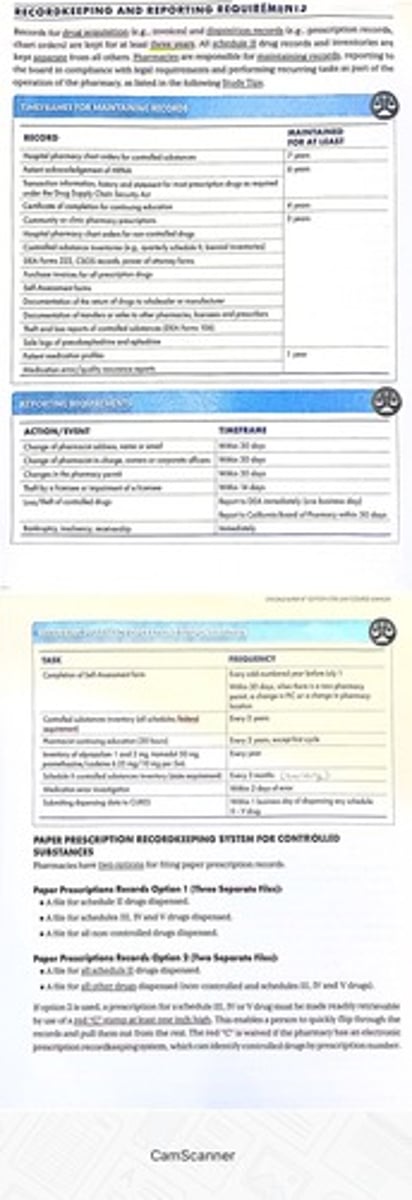
Timeframe for maintaining: Patient acknowledgement of HIPAA
6 years
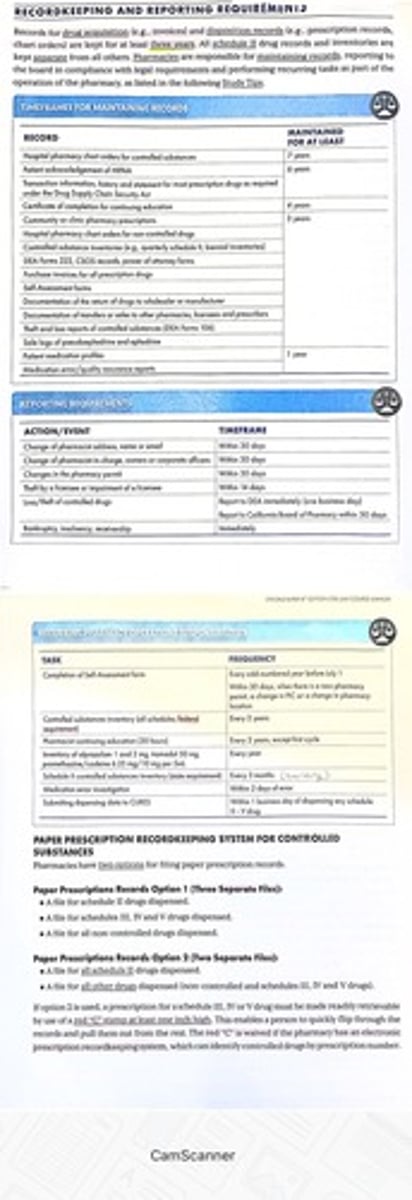
Timeframe for maintaining: Transaction information, history, and statement for most prescription drugs (required under Drug Supply Chain Security Act)
6 years
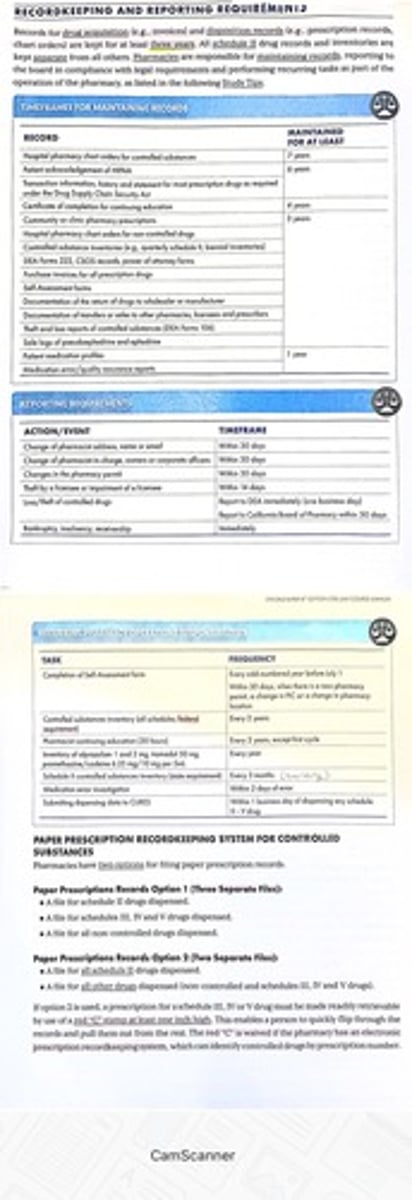
Timeframe for maintaining: Certificate of completion for Continuing Education
4 years
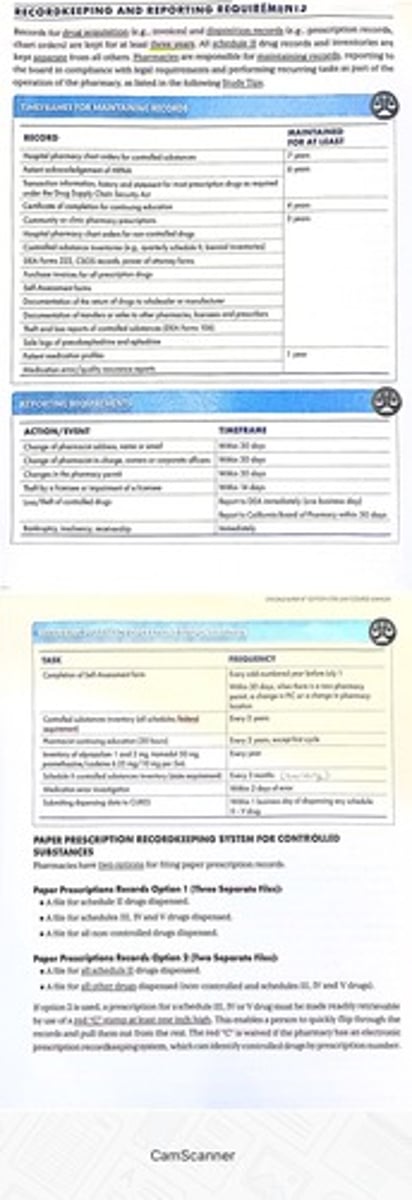
Timeframe for maintaining: Community or clinic pharmacy prescriptions
3 years
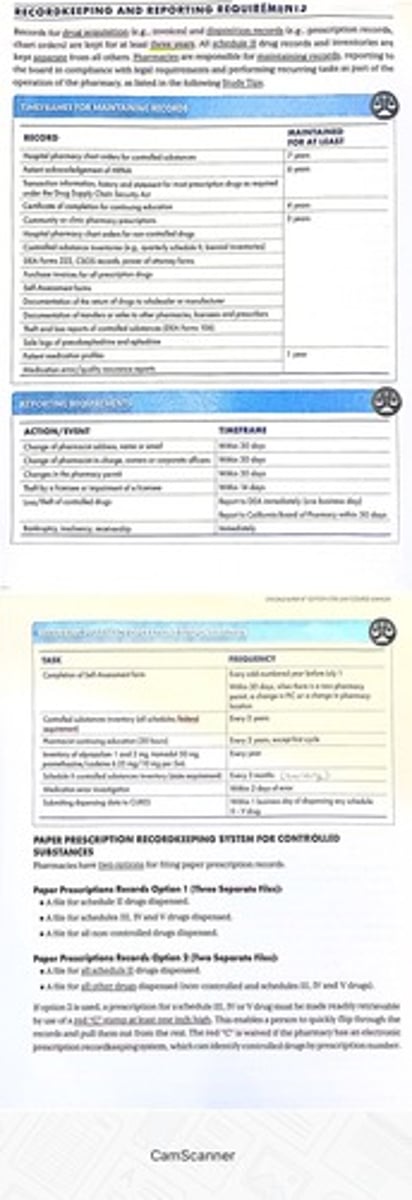
Timeframe for maintaining: Hospital pharmacy chart orders for non-controlled drugs
3 years
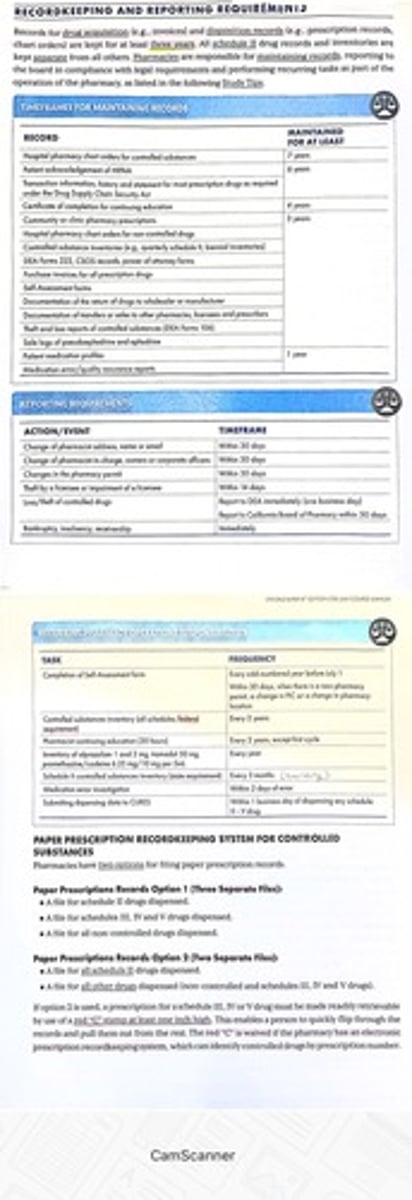
Timeframe for maintaining: Controlled susbtance inventories
3 years
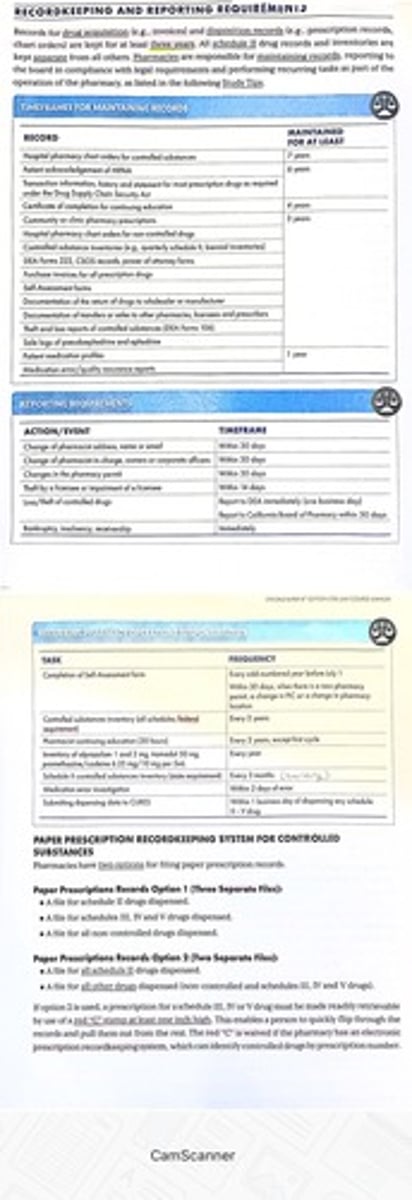
Timeframe for maintaining: DEA forms 222, CSOS records, power of attorney forms
3 years
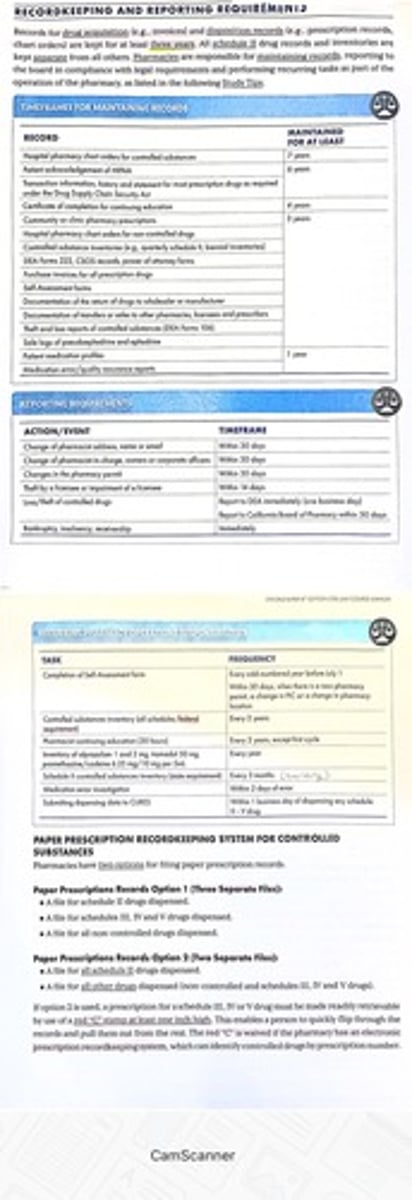
Timeframe for maintaining: Purchase invoices for all prescription drugs
3 years

Timeframe for maintaining: Self-assessment forms
3 years
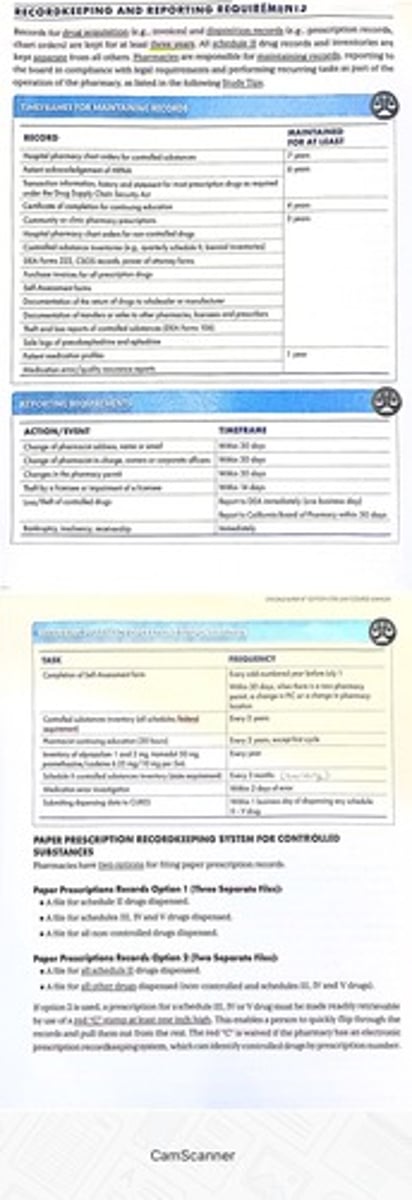
Timeframe for maintaining: Documentation of the return of drugs to wholesaler or manufacturer
3 years
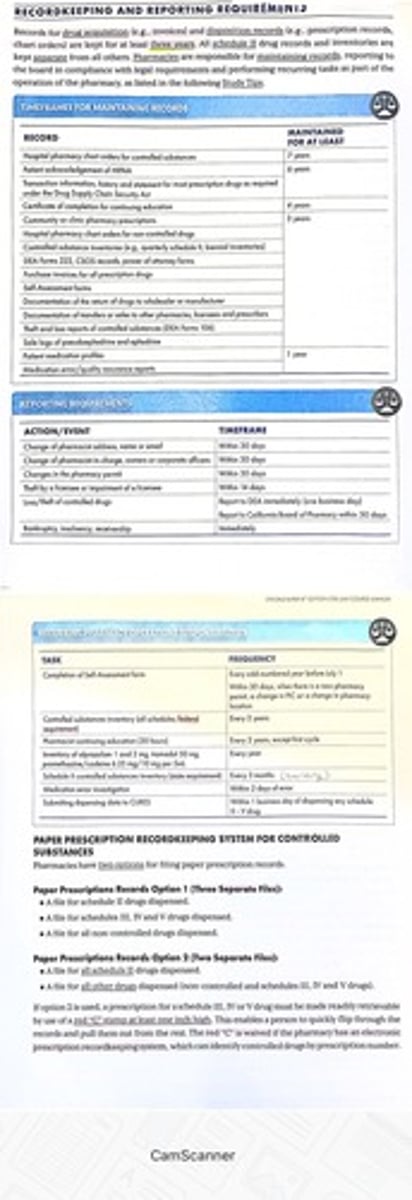
Timeframe for maintaining: Documentation of transfers or sales to other pharmacies, licensees, & prescribers
3 years
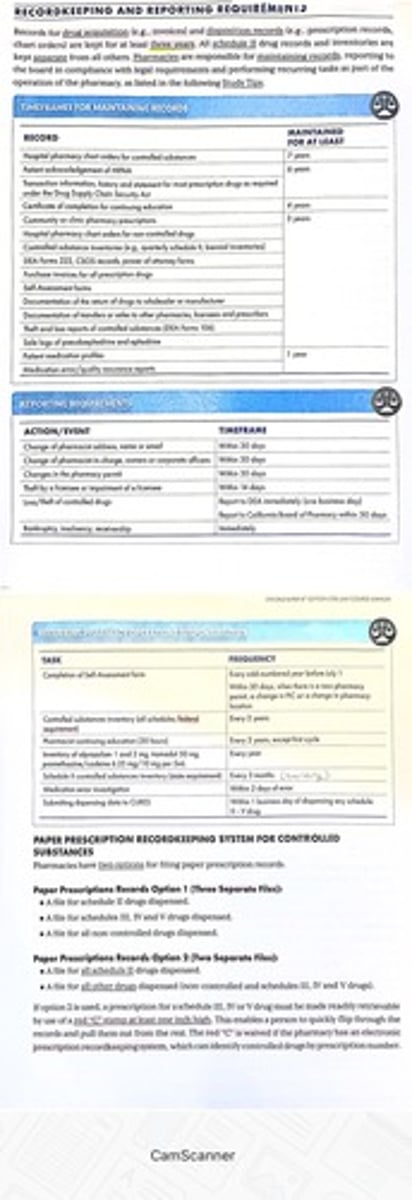
Timeframe for maintaining: Theft and loss reports of controlled substances (DEA forms 106)
3 years
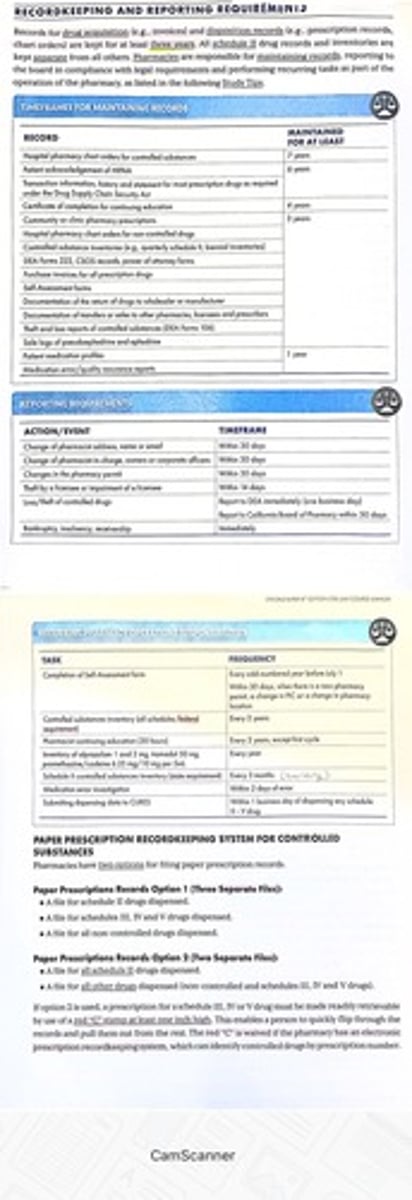
Timeframe for maintaining: Sale logs of pseudoephedrine and ephedrine
3 years
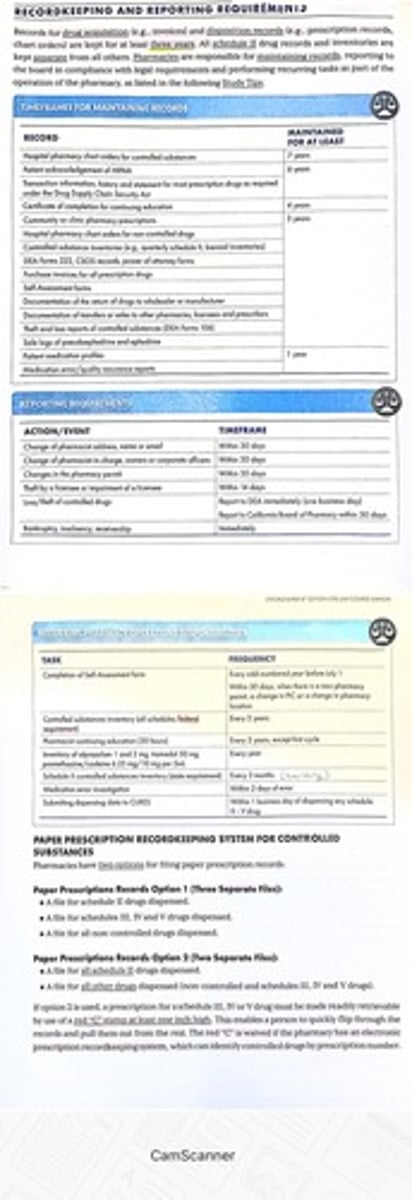
Timeframe for maintaining: Patient medication profiles
1 year
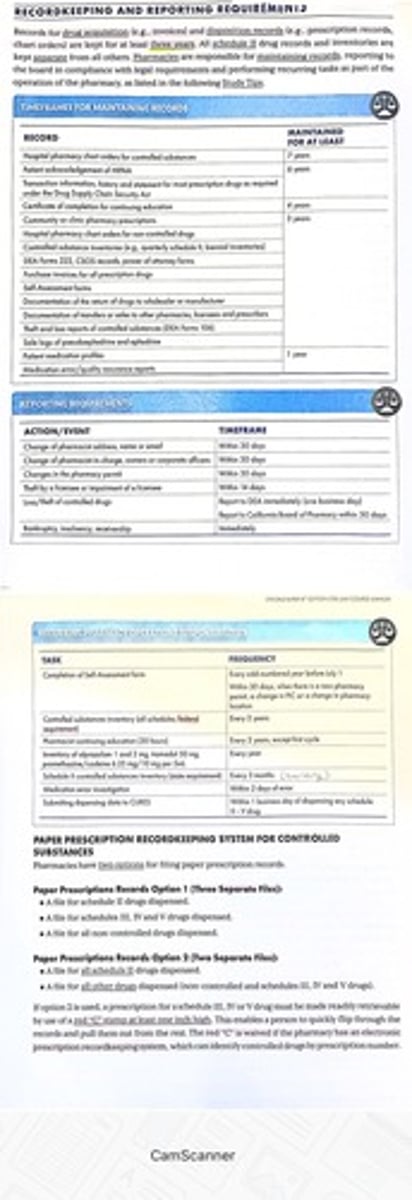
Timeframe for maintaining: Medication error/quality assurance reports
1 year
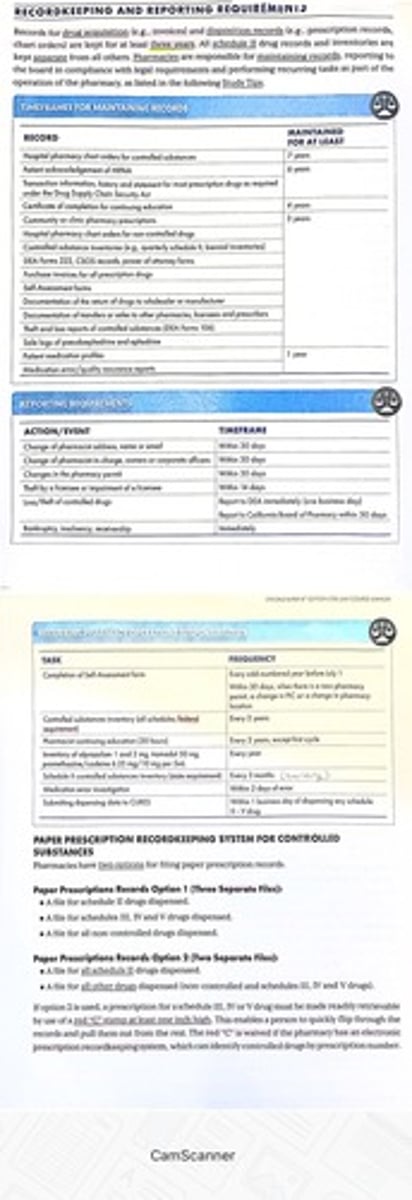
Reporting requirements: Change of pharmacist address/name/email
within 30 days

Reporting requirements: Change of pharmacist-in-charge, owners, or corporate officers
within 30 days
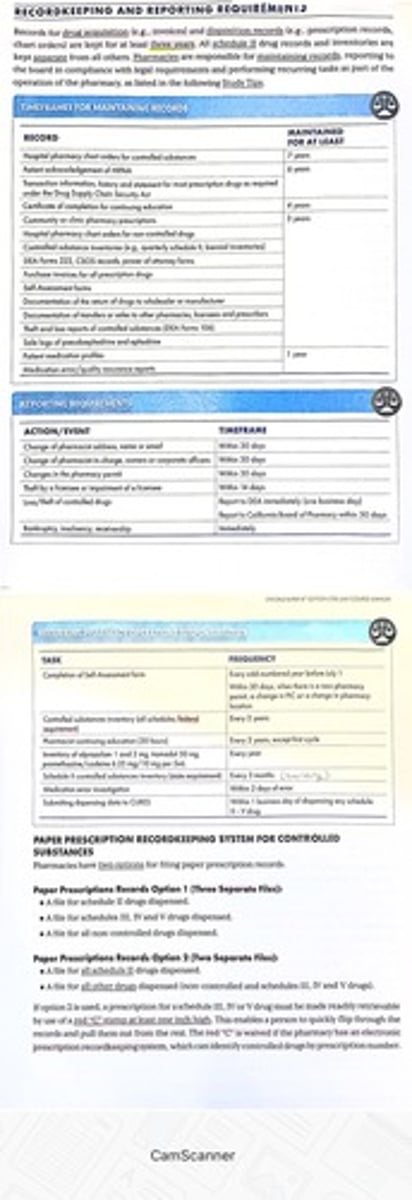
Reporting requirements: changes in pharmacy permit
within 30 days
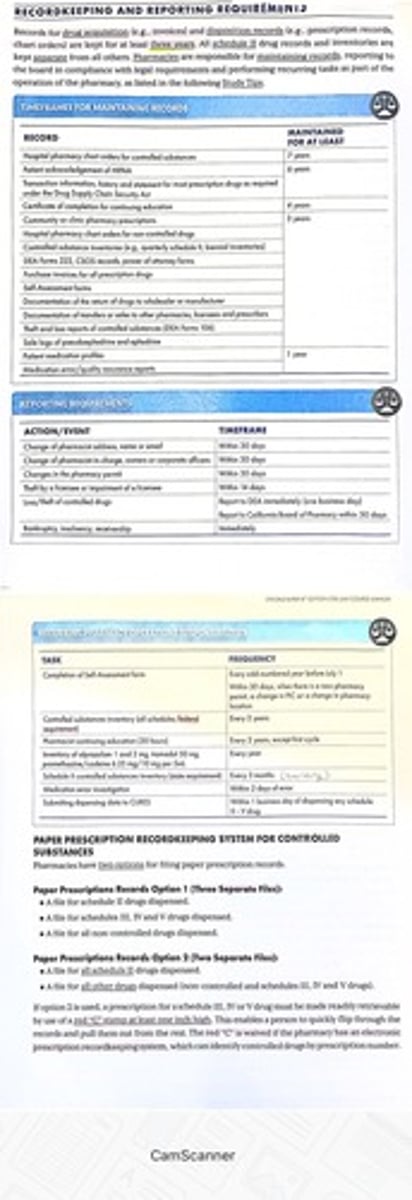
Reporting requirements: theft by a licensee or impairment of a licensee (pharmacist/intern)
within 14 days
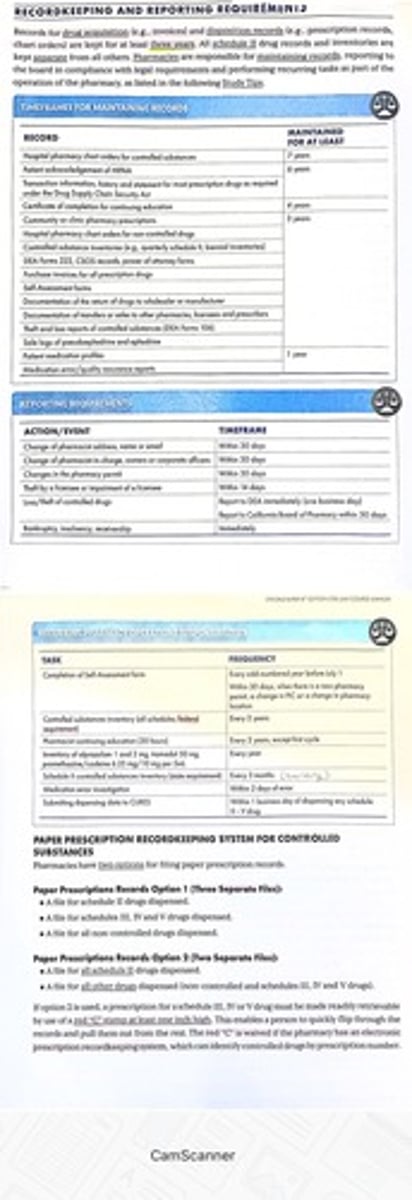
Reporting requirements: loss/theft of controlled drugs
Report to DEA immediately (one business day). Report to California Board of Pharmacy within 30 days.
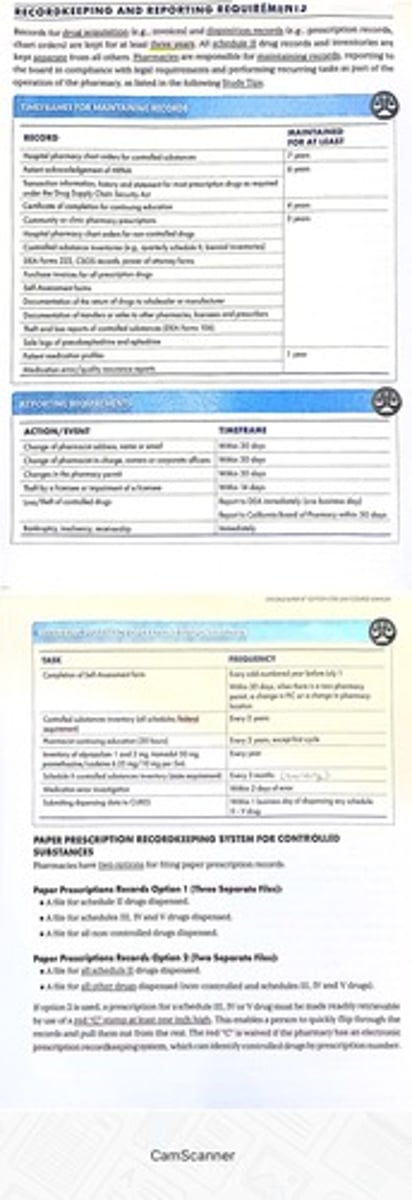
Reporting requirements: bankruptcy, insolvency, receivership
immediately
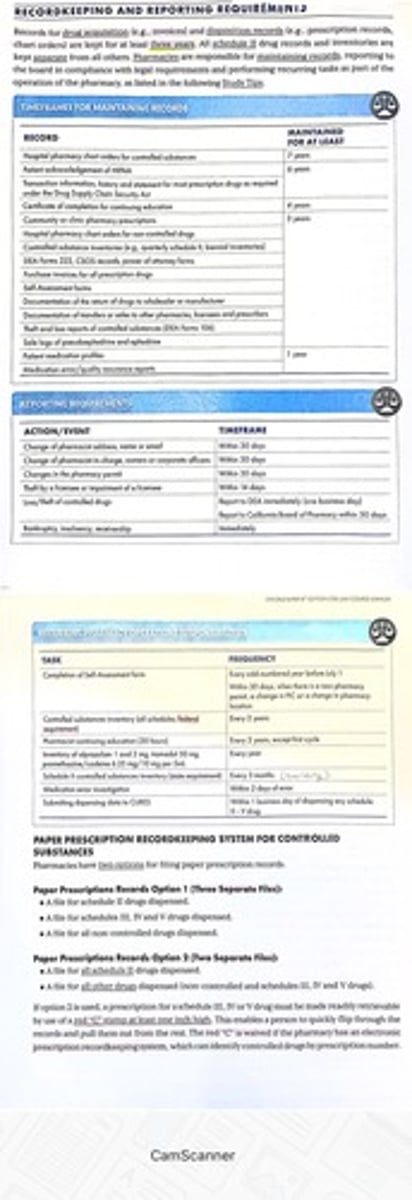
Frequency of pharmacy operation: Completion of self-assessment form
Every odd-numbered year before July. Within 30 days when new pharmacy permit/change in PIC/change in pharmacy location.
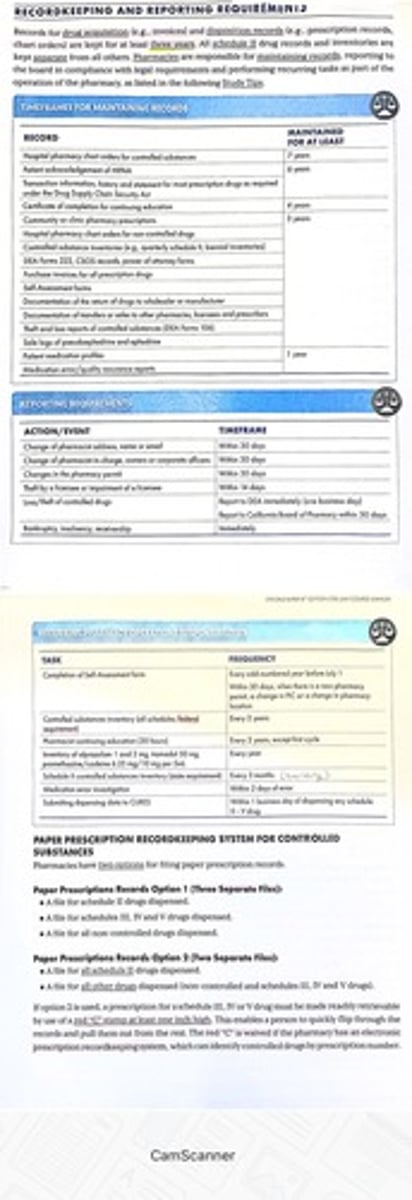
Frequency of pharmacy operation: Controlled substances inventory (all schedules)(federal requirement)
every 2 years
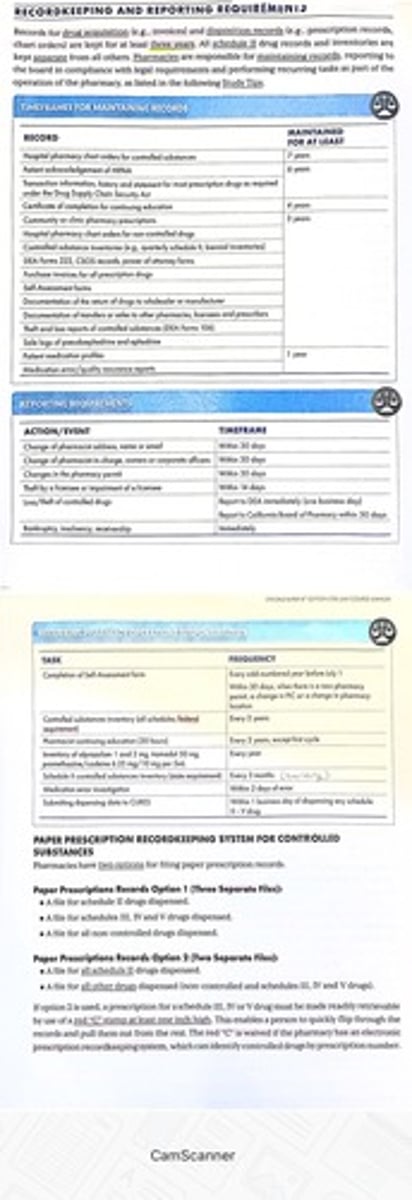
Frequency of pharmacy operation: Pharmacist continuing education (30 hrs)
every 2 years except first cycle
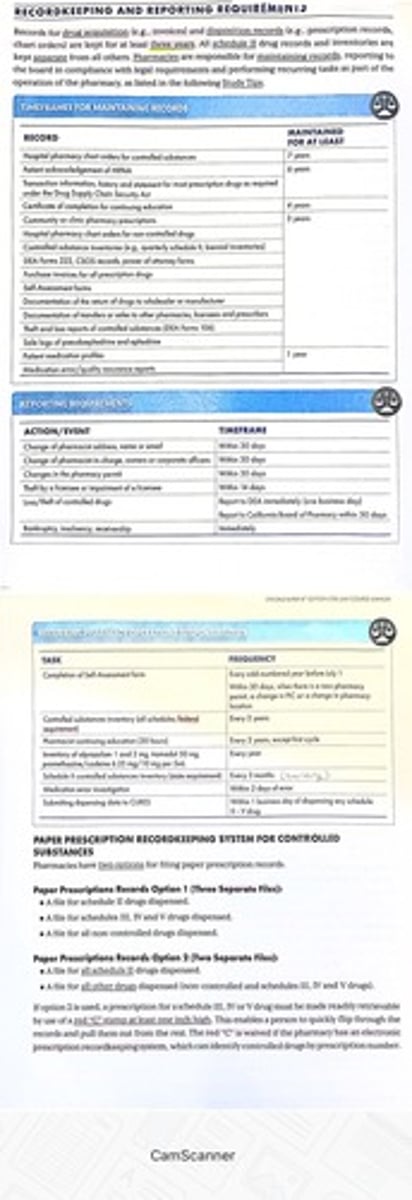
Frequency of pharmacy operation: Inventory of Alprazolam 1 and 2 mg, Tramadol 50 mg, Promethazine/Codeine 6.25 mg/10mg per 5 mL
every year

Frequency of pharmacy operation: Schedule II controlled substances inventory (state requirement)
every 3 months (quarterly)

Frequency of pharmacy operation: Medication error investigation
Within 2 days of error
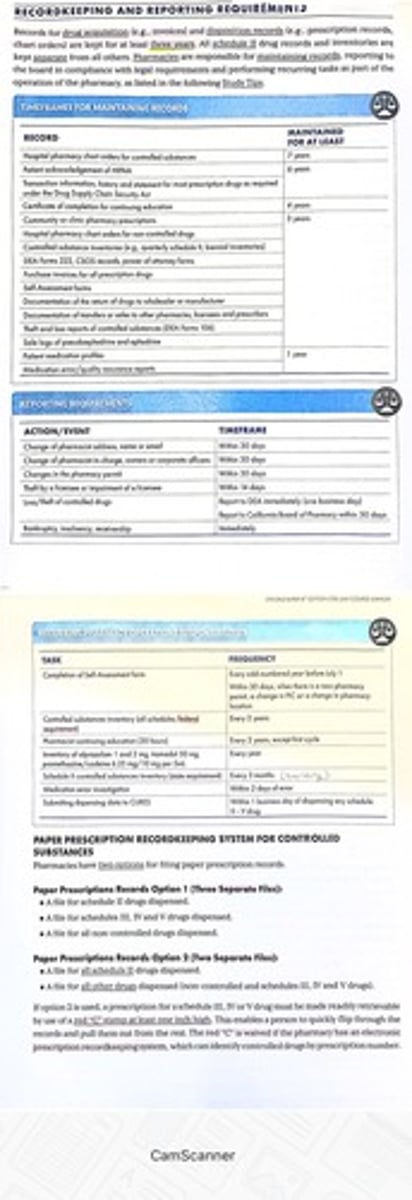
Frequency of pharmacy operation: Submitting dispensing data to CURES
within 1 business day of dispensing any schedule II - V drug
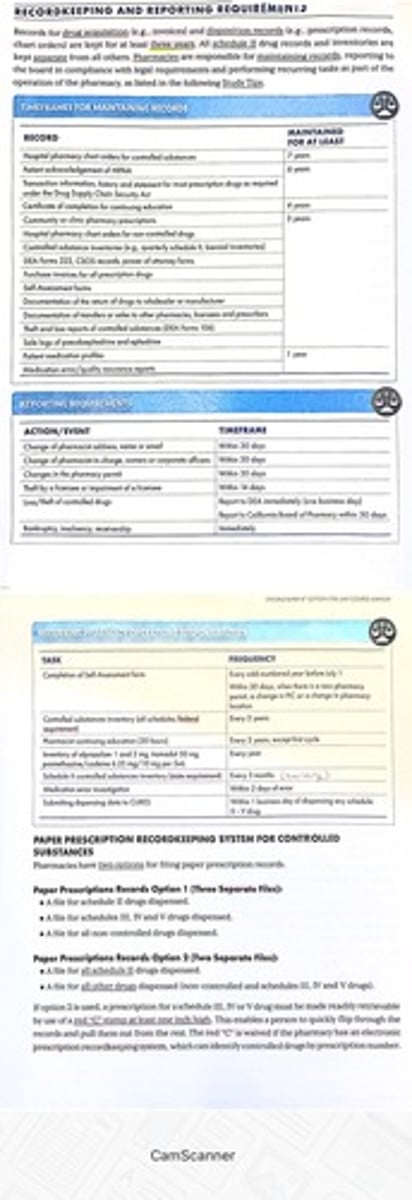
To be a licensed as a pharmacist, a candidate must have completed how many hours of pharmacy practice experience?
1500 hours of pharmacy practice experience
When must all licensees join the board's email notification list?
Within 60 days of becoming licensesd
How many hours of continuing education do all registered pharmacists need? Frequency? Requirements for these hours?
30 hours of CE during each two-year license period (1 hour course on cultural competency and at least 2 hours on pharmacy law and ethics)
How many hours of continuing education do advanced practice pharmacists need? Frequency?
10 hours of CE per cycle in addition to the 30 hours per licensed period
What activities are pharmacy clerks allowed to complete? What are they NOT allowed to complete?
Type a prescription label and enter prescription information into a computer. Request and receive refill authorizations. Put medications back on the shelf and give prescriptions to patients. They are NOT allowed to pull drugs from shelf or fill prescriptions.
if pharmacist suspects another pharmacist is impaired at work, they must report to board within
Within 14 days
Inventory records of schedule II drugs must be kept ____ from all other controlled substances. There [is/is not] a requirement to submit a copy of the inventory to the DEA?
Separate; NOT a requirement
True/false: Inventory should be performed during business hours
FALSE, only at the beginning or close of business
If a drug becomes scheduled or changes schedules when do you inventory?
On the date the schedule became effective
Performing drug count:
For sealed, unopened containers of controlled substances an ____count is needed (don't open container just use the count on the label).
For opened containers of controlled substances:
Schedule 1 and 2 require _____ count
Schedule 3-5 with </= 1000 dosage units: ______count
Schedule 3-5 with >1000 dosage units: ______count
exact, exact, estimated, exact
Performing drug count:
For sealed, unopened containers of controlled substances an EXACT count is needed (don't open container just use the count on the label).
For opened containers of controlled substances:
Schedule 1 and 2 require EXACT count
Schedule 3-5 with </= 1000 dosage units: ESTIMATED count
Schedule 3-5 with >1000 dosage units: EXACT
What documentation is required for pharmacies to store records off-site? Where is this documentation kept? Pharmacy must be able to produce it within _____ upon request.
Waiver granted by the board; kept in the pharmacy; 2 days
Prescription records are kept for total three years. Prescriptions for non-controlled substances must be kept at the pharmacy for_________ . After that, the prescriptions can be stored off-site for _______ .
1 year; 2 years
Prescription records are kept for total three years. Prescriptions for controlled substances must be kept at the pharmacy for ________. After that, the prescriptions can be stored off-site for_______ .
2 years; 1 year
______ is needed to bill Medicare for Durable Medical Equipment (DME) and must include ______
Detailed Written Order (DWO); prescriber's signature and date,
True/false: Medicare does not accept PRN refills.
TRUE
If deliveries are made to a hospital pharmacy through a central receiving location, the drugs or devices must be delivered to the licensed pharmacy premises within _________ following the delivery.
one working day
Adulteration
Drug quality compromised
Misbranding
Incorrect or missing information on the label
How often are hospital drug supplies inspected by a pharmacist/intern/technician?
Every 30 days at least
Records of monthly inspections of hospital drug supply (which includes removing outdated, unusable, recalled, and misbranded drugs) must be kept for at least ______. Irregularities should be reported within______ to PIC and director/chief executive officer.
3 years; 24hrs
Which types of drugs are assigned a beyond-use-date?
Repackaged or Resold drugs
TRUE/FALSE: Drug samples are not allowed in retail pharmacies.
TRUE
Drug Recall
When a drug is removed from the market because it is defective or potentially harmful. Issued by FDA or the drug manufacturer.
True/false: The FDA mandates that the pharmacy contact the patient on drug recalls.
False
In a class I recall, the _________ is responsible for determining which patients received the drug & notifying each __________. The _______ must decide whether to inform the patient.
Pharmacist; patient's prescriber; prescriber
Class I recall
There is a reasonable probability that use of or exposure to the drug will cause serious adverse health consequences or death.
Class II recall
use or exposure will cause temporary/reversible adverse health consequences, or where probability of harm is remote (ie possibility of particles in vials)
Class III recall
Use of or exposure is NOT likely to cause adverse health consequences
When drug recalled is a compounded product, pharmacy or outsourcing facility must contact the recipient if?
- use of/exposure to compounded drug can cause serious adverse health effects or death
- recalled drug was dispensed or is intended for use in California
How quickly must pharmacies notify recipient and board of pharmacy of issuing a recall for compounded product?
12 hours
For a recall on a compounded product from an outsourcing facility, recipient must be notified within?
24 hours
If pharmacy is made aware that patient has been harmed by a compounded product prepared by the pharmacy, the pharmacy must report event to what program? How quickly for non-sterile products? How quickly for sterile products?
FDA MedWatch program
Within 72 hours for non sterile products
Within 12 hours for sterile products prepared in a hospital
Immediately for sterile products prepared by all other pharmacies (ie compounding or nonresident pharmacies)
If an outsourcing facility is made aware that patient has been harmed by a compounded product prepared by the facility, the facility must report event to what program? How quickly?
FDA MedWatch program
Within 15 calendar days
FDA's Flush List examples
Buprenorphine
Diazepam rectal gel
Fentanyl-containing products
Hydrocodone-containing products
Hydromorphone
Methadone
Methylphenidate transdermal system (Daytrana patch)
Morphine
Oxycodone-containing products
Oxymorphone
Tapentadol
When to notify to the board:
Establishment or discontinuation of a drug take-back service
Within 30 days
When to notify to the board:
Tampering of drug take-back collection bin
Theft of deposited drug in collection bin
Tampering/damage/theft of a removed liner
Within 14 days
When to notify to the board:
Disclosure of service and location of each drug take-back receptacle
annually, at time of facility license renewal
Don't Rush to Flush CA BOP campaign: 3 steps
- Obscure/remove personal info from containers and recycle them
- Place pills in clear, zipper bag; keep liquids and creams in original containers
- Place into bin at a Don't Rush to Flush Location
If pt cannot dispose of unwanted drug (excluding those on FDA flush list) using Don't Rush to Flush, then dispose using following 3 steps
- Remove drug from original container
- Mix with undesirable substance (kitty litter, coffee grounds)
-Place mixture into sealable bag or empty container and discard in trash
Each person licensed by the BOP are "mandated reporters" of child abuse, elder abuse, and neglect. A report should be made when there is a reason to believe that a child/elder is a victim of abuse or neglect. The mandated reporters must phone law enforcement or protective services as soon as they can and prepare & send a written report within _____ working days or _____hrs of receiving the information concerning the incident. Failure to do so is a misdemeanor, punishable by up to 6 months in county jail &/or fine of $1,000.
Within 2 working days; 36 hours of receiving information
Prescribing authority for providers controlled and non-controlled
see pt 32
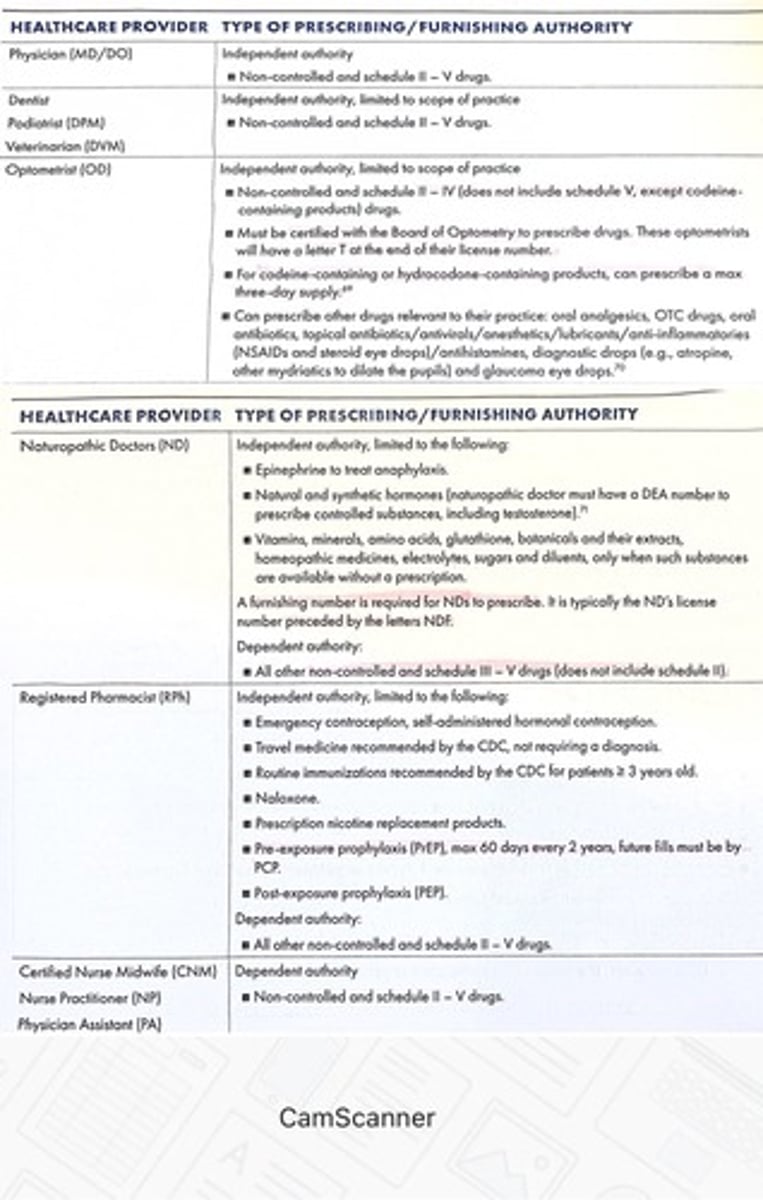
True/False: Prescribers can self-prescribe non-controlled and controlled substances.
False; can only self-prescribed non-controlled substances
What are the requirements for prescriber to prescribe controlled/non-controlled rx to family?
- valid physician/patient relationship
- legitimate medical purpose
- good faith exam
If a prescriber is deceased, and a valid prescription was written when the prescriber was living, the prescription is valid until___?
until all refills are gone and no more than standard of practice (6 months from date written for controlled and 1 year for non-controlled)
True/False: District of Columbia and U.S. territories (e.g. Puerto Rico, the Virgin Islands, Guam, American Samoa) are treated the same as U.S. states for filling prescriptions.
True
RPh can dispense a drug/device of a written/oral order of a prescriber licensed in another state if___.
- out-of state prescriber has license equivalent to California prescriber
- Rph should verify license to see if they are authorized to prescribe
Requirements for valid prescription:
- Patient name/address
- Drug name, quantity and directions for use
- Date of issue
- Prescriber info (name, business address, telephone #, license classification, DEA # if controlled substance is prescribed)
- Conditions/purpose of prescribed drug if requested by the patient
- Prescriber signature
True/False: Medication orders or chart orders are similar to prescription but for institutionalized patients (i.e. patients in a hospital or long term care facilities) and must be handwritten.
False, prescriber can handwrite or enter into patients electronic medical record. Prescribers can also issue face-to-face verbal or telephone orders.
True/False: A prescriber can issue a verbal order and authenticate it at a later time (for example in an emergency situation/code blue).
True, a prescriber can verbally instruct a nurse to administer a medication to a patient. The nurse would enter the order, note the prescriber's name and sign the order. Then the prescriber has 48 hrs to physically/electronically countersign the order.
All prescriptions for drugs issued in CA must be transmitted electronically unless it meets one of the following exceptions:
- Rx issued by veterinarian
- Rx issued in hospital ED or urgent care if the pt is homeless without a preferred pharmacy, pt lives outside CA/the geographic area, or the rx is issued when the preferred pharmacy is closed
- Rx will be dispensed outside of CA
- Electronic data transmission is unavailable due to temporary tech/electronic failure
True/False: An employee/agent under the supervision of the prescriber can transmit prescriptions for non-controlled AND schedule 3-5 drugs to a pharmacist or prepare a prescription for the prescriber to sign/date.
True; the pharmacist must document who is sending the rx on behalf of the prescriber
The Centers for Medicare and Medicaid Services (CMS) requires tamper resistant pads for all Medi-Cal outpatient prescriptions in order to be reimburse by the government. What are the 3 security features required and does a California security form fulfill these requirements?
3 security features:
- Prevent unauthorized copying of prescription form (watermarks and "VOID" if photocopied)
- Prevent erasure/modification of information written by provider (ex. check boxes for quantity and refills)
- Prevent use of counterfeit prescription (ex. serial number, thermochromic ink, microprint signature line)
Yes the California security form actually exceeds these requirements and can be used to prescribe outpatient drugs for Medi-Cal beneficiaries
Ways to correct errors/omissions on a prescription
- Pharmacist can revise for non-controlled drugs if it is minor (e.g. misspelling drug name) OR after consultation with provider if it is significant. Pharmacist must document this discussion.
- Rx can be re-written as oral prescription after verification with prescriber. Original rx will be voided.
- Prescriber can resend another prescription electronically or through fax.
A 30-day rx can be converted to a 90-day if the following requirements are met:
- Rx is not for controlled substance of psychiatric drug
- Pt has completed initial 30-day supply with no negative effects OR has received a 90-day supply of the med before
- Total quantity dispensed including refills doesn't exceed amt authorized on the rx
- Pharmacist notifies the prescriber of the larger qty dispensed
- Prescriber doesn't indicate either orally or in writing "No change in quantity" or something similar OR that the prescribed amt is medically necessary
True/False: Health plans are required to provide coverage for up to 12-month supply of hormonal contraceptives.
True; at a patient's request and with a valid rx, the pharmacy can dispense up to 12 month supply of hormonal contraceptive at one time as long as:
- the total quantity dispensed doesn't exceed the amount authorized in the rx
- the prescriber doesn't indicate that there cannot be any change to the quantity OR that the dispensing amount is medically necessary
In order to have an automatic prescription refill program, pharmacies must____.
- have policies/procedures in place
- provide program information
- confirm with the patient each time an rx is refilled
- complete a drug regimen review before refilling
- obtain annual renewal of each rx from the patient
- keep a copy of consent for 1 year from the date of dispensing
- maintain documentation of program withdrawal for 1 year
Refill limits for drugs
- non-controlled: no refill limit, but can't be dispensed after 1 year from date of issue
- schedule V: no refill limit, up to 6 months from the date of issue
- schedule III and IV: up to 5 times in 6 months and total of all refills dispensed can't exceed a 120 day supply (excluding the original fill)
- schedule II: no refills allowed
PRN refills for non-controlled substances are ___. A 30-day supply with PRN refills can be refilled ____before it expires. A 90-day supply can be dispensed ___ before it expires.
PRN refills for controlled substances are ___.
acceptable
11 times; 4 times (original fill, then 3 refills)
not acceptable